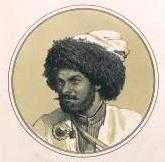Hadji Murad

Hadji Murad (Russian: Хаджи-Мурат, Avar: XӀажи Мурад) (late 1790s - April 23 (N.S. May 5), 1852) was an important Avar leader during the resistance of the peoples of Dagestan and Chechnya in 1811-1864 against the incorporation of the region into the Russian Empire.
Life
Alliance with Russia
Hadji Murad was an Avar commander who lived in the Caucasus. He was foster-brother to Omar, Pakkou-Bekkhe, the Khanum of Khunzak's son. Hadji Murad was involved in the murder of Gamzat-bek during a Friday prayer in 1834, in revenge for Gamzat's murdering of the Khanum and her sons. Murad's brother, Osman, was slain in the fight with Gamzat-bek's Murids.
Hadji Murad supported the Russians for a while, to counter what he saw as the threat of Muridism. His rival, Akhmet Khan, set about undermining Russian confidence in Murad, until they ordered his arrest, which was carried out by Akhmet Khan. General Mikhail Semyonovich Vorontsov demanded that he be brought into general headquarters. Hadji Murad contrived to escape, by flinging himself over the ledge of a narrow mountain-pass. The Russians gave him up for dead. The snow, however, had broken his fall and he lay in hiding for the winter. Because of the Russian's bad faith, he decided to throw his lot in with Imam Shamil, who bestowed upon him the rank of naib. Many tribes followed Hadji Murad, defecting from the Russians.
Exploits and service under Shamil
His exploits and red dress earned him the nickname of the 'red devil' from the Russians. After an ineffectual raid on Russian headquarters at Temir-Khan-Shura, a rumour spread that he had slaughtered all the Russians in the hospital and cut them up into shashliks, which he left behind for the Russian troops to eat unawares. Though false, this rumour gained much credence among the Russians and vilified Hadji Murad's reputation.
Defection to Russia
In 1851, a feud broke out between him and Shamil, when Shamil proclaimed his son, Khazi Mohammed, as the successor. In a secret meeting, Shamil and his naibs decided that Hadji Murad should be killed. An unknown naib warned him and he managed to escape in time, but his family were held captive. Hadji Murad surrendered to the Russians, who lionised but mistrusted him. He repeatedly asked to be given men and guns to attack Shamil and rescue his family, but received no firm reply. He was allowed to move from Tblisi to the small Muslim town of Noukkha (now Shaki, Azerbaijan) accompanied by a Cossack escort. Hadji Murad planned an escape, which he carried out on April 24 (Old style calendar), 1852, during one of his morning rides. The Cossack guards were ambushed and killed but the town's garrison, led by Colonel Karganov, tracked Hadji Murad down. The Russians were joined by many tribesmen, including Akhmet Khan's son and Hadji Murad was killed in the ensuing fight. The young Akhmet Khan cut off the head and sent it to Tblisi, where it was embalmed and then sent to the Emperor. Tolstoy places Murad's death near the minaret of Belarjik (probably referring to the latterday town of Biləcik on the Shaki to Qax road) but a commemorative grave marker is further south near km76 on the Shaki-Zaqatala road.[1]
In fiction
Leo Tolstoy's posthumously published novel Hadji Murat (1912) is a fictionalized account of Murad's struggle with the Russian Empire. His image also appears in My Dagestan, a novel of the Avars writer Rasul Gamzatov
Agi Murad il diavolo bianco (1959) – in English, The White Warrior – is an Italian movie account of Murad's struggle with the Russian Empire. Murad is played by Steve Reeves.
References
- ↑ Elliott, Mark (2010). "Azerbaijan with excursions to Georgia" (4th edition). p. 229.
Additional reading
- Lesley Blanch "The Sabres of Paradise".
External links
|